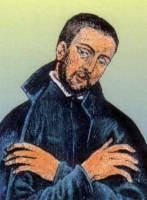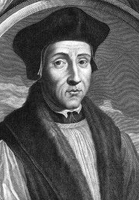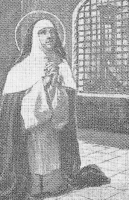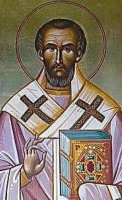St. Orentius
Feastday: June 24
Death: 304
Martyr with Heros, Pharnacius, Firminus, Firmus, Longinus, and Cyriacus. According to the pre-1970 Roman Martyrology, they were seven brothers who were stripped of their positions in the Roman army and executed during the reign of co-Emperor Maximian.
Orentius was one of seven brothers, which included Cyriacus, Firminus, Firmus, Heros, Longinus, and Pharnacius. They were all soldiers in the Roman Army, who lost their positions for being Christians. They all suffered martyrdom, during the persecutions of co-Emperor Maximian
St. Mother Maria Guadalupe Garcia Zavala ~ Mother Lupita
Feastday: June 24
Birth: 1878
Death: 1963
Beatified: 25 April 2004, Saint Peter's Square, Vatican City by Pope John Paul II
Canonized: 12 May 2013, Saint Peter's Square, Vatican City by Pope Francis
Saint Mother Maria Guadalupe Garcia Zavala was co-founder of the Congregation of the Handmaids of St. Margaret Mary Alacoque and the Poor, and was the first mother superior of the congregation. She was beautified by Pope John Paul II on April 25, 2004, and will be canonized on May 12, 2013.
Maria was born on April 27, 1878 in Zapopan, Jalisco, Mexico. Her father, Fortino, ran a religious goods store situated in front of the Basilica of Our Lady of Zapopan. She had a special devotion to the Lady and she made frequent prayers in the basilica.
As a young woman, she made plans to marry, however she ended these plans as she felt called to religious life.
She then pursued religious life and co-founded a new congregation on October 13, 1901, known as the Handmaids of St. Margret Mary Alacoque and the Poor. Maria spent most of her time serving as a nurse and as the Mother Superior General of the congregation.
The Congregation grew rapidly and served ever more people. However, she was also devoted to poverty, saying that only by being poor can one be with the poor. She sometimes begged for money on the street to help meet the needs of the Congregation and the patients they served.
The sisters of the Congregation also served in nearby parishes and teaching catechism.
During the Mexican Revolution, a time of great persecution for the Catholic Church which lasted from 1911 to 1936, Mother Maria hid priests and even the Archbishop of the Archdiocese of Guadalajara in her hospital, saving them from their enemies.
Maria led the Congregation as it grew to 11 foundations in Mexico. Since her death on June 24, 1963, the Congregation has grown to include 22 houses in five different countries, with the most in Mexico.
Maria was declared venerable on Pope John Paul II on July 1, 2000, and beautified on April 25, 2004. She will be canonized by Pope Francis on May 12, 2013.
Nativity of Saint John the Baptist
திருமுழுக்கு யோவானின் பிறப்பு
(24-06-2021)
ஹெப்ரோன் என்ற மலைநாட்டில் வாழ்ந்த எலிசபெத்து செக்கரியா தம்பதியினருக்கு அவர்களுடைய முதிர்ந்த வயதில் குழந்தை ஒன்று பிறந்தது. அக்குழந்தைக்கு விருத்தசேதனம் செய்யவேண்டிய எட்டாம் நாள் வந்தது. அந்நாளில் அக்கம் பக்கத்து வீட்டிலிருந்தவர்கள் அனைவரும் அங்கு வந்திருந்தனர். அவர்கள் குழந்தையின் தந்தையினுடைய பெயரான செக்கரியா என்பதையே அதற்குச் சூட்ட இருந்தனர். ஆனால் குழந்தையின் தாயோ, குழந்தைக்கு யோவான் என பெயரிடச் சொன்னார். இதை கேட்ட மக்கள் குழப்பம் அடைந்தார்கள். வழக்கமாக தந்தையின் பெயரைத்தானே மகனுக்குச் சூட்டுவது வழக்கம். ஆனால் இவர் உறவினர்களிடத்தில் இல்லாத வேறொரு பெயரைச் சூட்டச் சொல்கிறாரே என நினைத்து, குழந்தையின் தந்தையாகிய செக்கரியாவிடம், “குழந்தைக்கு என்ன பெயரிடலாம்?” என்று சைகை காட்டிக் கேட்டார்கள். அதற்கு அவர் ஒரு எழுது பலகையைக் கேட்டு வாங்கி, அதில் யோவான் என்று எழுதினார். இதைக் கண்ட மக்கள்கூட்டம் வியந்துபோய் நின்றது. அப்போது வானதூதர் கபிரியேல் முன்னறிவித்தது போன்று செக்கரியாவின் நாவு கட்டவிழ்ந்தது.
வரலாற்றுப் பின்னணி
திருச்சபை புனிதர் ஒருவரின் இறப்பை – விண்ணகப் பிறப்பைத்தான் – விழாவாகக் கொண்டாடும். ஆனால் திருமுழுக்கு யோவானின் இறப்பு விழாவைக் கொண்டாடுவதோடு மட்டுமல்லாமல், பிறப்பு விழாவைக் கொண்டாடுகிறது என்றால் அவர் திருச்சபையில் எவ்வளவு முக்கியத்துவம் வாய்ந்தவர் என நாம் புரிந்துகொள்ளவேண்டும். திருச்சபை இறப்பு விழாவோடு பிறப்பு விழாவையும் கொண்டாடுகின்ற மற்ற இருவர் இயேசுவும் (டிசம்பர் 25), அன்னை மரியும் (செப்டம்பர் 08) அவர்.
ஆண்டவர் இயேசு சொல்வது போன்று திருமுழுக்கு யோவான் சாதாரண மனிதர் அல்ல, அவர் மனிதராகப் பிறந்தவர்களுள் பெரியவர் (மத் 11:11), மற்ற இறைவாக்கினர்கள் தாயின் கருவில் இருக்கும்பொழுது தேர்ந்து கொள்ளப்பட்டவர்களாக இருக்கலாம், ஆனால் திருமுழுக்கு யோவானோ தாயின் கருவில் இருக்கும்போது தூய ஆவியினால் முற்றிலுமாக ஆட்கொள்ளப்பட்டவர். (லூக் 1: 41), மற்ற இறைவாக்கினர்கள் மெசியாவைக் குறித்து முன்னறிவித்தார்கள். ஆனால் திருமுழுக்கு யோவானோ ஆண்டவர் இயேசுவின் வருகைக்காக மக்களைத் தயாரித்தார், அவர் வந்தபோது சுட்டிக்காட்டினார், அவருக்குத் திருமுழுக்குக் கொடுத்தார். அதனாலேயே திருமுழுக்கு யோவான் மற்ற எல்லா இறைவாக்கினர்களையும் விட உயர்ந்தவராக இருக்கின்றார்.
திருமுழுக்கு யோவானின் பெற்றோர்களான செக்கரியாவும் எலிசபெத்தும் நீண்ட நாட்களாகியும் குழந்தைப் பேறு இல்லாமல் இருந்தார்கள். இருந்தாலும் அவர்கள் கடவுளுடைய பார்வையில் நேர்மையுள்ளவர்களாக இருந்தார்கள் (லூக் 1:6), அதனால்தான் கடவுள் அவர்கள்மீது இரக்கம்கொண்டு அவர்களுக்கு குழந்தைப் பேற்றினைத் தருகின்றார்.
ஆரோனின் வழிவந்தவரனான செக்கரியா எருசலேம் திருக்கோவிலில் தூபம் காட்டுகின்ற முறை வந்தபோது உள்ளே செல்கிறார். அப்போது ஆண்டவரின் தூதர் அவருக்குக் காட்சி கொடுத்து, “செக்கரியா, அஞ்சாதீர், உமது மன்றாட்டு கேட்கப்பட்டது. உம் மனைவி எலிசபெத்து உமக்கு ஒரு மகனைப் பெற்றெடுப்பார்; அவருக்கு யோவான் எனப் பெயரிடுவீர்” என்கிறார். இவ்வார்த்தைகளைக் கேட்டு செக்கரியா, “இது நடைபெறும் என எனக்கு எப்படித் தெரியும்? நான் வயதானவன். அதுபோல் என் மனைவியும் வயது முதிர்ந்தவர் ஆயிற்றே” என்கிறார். உடனே வானதூதர் அவரிடம், “நான் கபிரியேல்; கடவுளின் திருமுன் நிற்பவன்; உம்மோடு பேசவும் இந்த நற்செய்தியை உமக்கு அறிவிக்கவும் அனுப்பப்பட்டேன். உரிய காலத்தில் நிறைவேற இருக்கும் என்னுடைய வார்த்தைகளை நீர் நம்பவில்லை. ஆதலால், அவை நிறைவேறும் வரை நீர் பேச்சற்றவராய் இருப்பீர்” என்று ஆணையிட்டுவிட்டுச் செல்கிறார். விவிலியத்தில் வயது முதிர்ந்த தம்பதியினருக்கு இறைவன் குழந்தைப் பேற்றை அளித்திருகிறார் என்பதைத் தெரிந்தபின்னும்கூட செக்கரியா வானதூதரின் வார்த்தைகளை நம்பாததனால்தான் அவர் வானதூதரின் சினத்திற்கு உள்ளாகின்றார். யோவானின் பிறப்புக்குப் பிறகு அவர்மீது விழுந்த சாபம் விலகுகின்றது, அவருடைய நா கட்டவிழ்கிறது.
செக்கரியாவிற்கு நா கட்டவிழ்ந்த பிறகு அவர், கடவுள் ஆற்றிவரும் இரக்கச் செயல்களுக்காக அவருக்கு நன்றி செலுத்துகின்றார். அதே நேரத்தில் தன் மகன் மெசியாவிற்கு முன்னோடியாக இருந்து ஆற்ற இருக்கும் பணிகளைக் குறித்து எடுத்துரைக்கின்றார். யோவான் வளர்ந்த பிறகு தன்னுடைய தந்தை முன்னறிவித்தது போன்று ஆண்டவருக்காக மக்களைத் தயார்செய்து, அவரை மக்களுக்குச் சுட்டிக்காட்டி, அறநெறிக்குப் புறம்பாக வாழ்ந்த ஏரோதின் தவற்றைச் சுட்டிக்காட்டி, அவராலேயே கொல்லப்பட்டு இறந்தார். திருமுழுக்கு யோவான் விவிலியத்தில் வந்த கடைசி இறைவாக்கினராக இருந்தாலும் அவர் மனிதர்களாய் பிறந்தவர்களுள் உயர்ந்தவராக விளங்குகின்றார்.
Also known as
• Iohannes Baptista
• Joannes Baptista
• John the Baptizer
• John the Forerunner
• John, son of Zachary
• Juan Bautista
• Yochanan ben Zecharyah
Memorials
• 24 June (birth)
• 29 August (death)
Profile
Cousin of Jesus Christ. Son of Zachary, a priest of the order of Abia whose job in the temple was to burn incense; and of Elizabeth, a descendent of Aaron. As Zachary was ministering in the Temple, an angel brought him news that Elizabeth would bear a child filled with the Holy Spirit from the moment of his birth. Zachary doubted and was struck dumb until John's birth.
Prophet. John began his ministry around age 27, wearing a leather belt and a tunic of camel hair, living off locusts and wild honey, and preaching a message of repentance to the people of Jerusalem. He converted many, and prepared the way for the coming of Jesus. He Baptized Christ, after which he stepped away and told his disciples to follow Jesus.
Imprisoned by King Herod. He died a victim of the vengeance of a jealous woman; he was beheaded, and his head brought to her on a platter. Saint Jerome says Herodias kept the head for a long time after, occasionally stabbing the tongue with his dagger because of what John had said in life.
Died
• beheaded c.30 at Machaerus
• buried at Sebaste, Samaria
• relics in Saint Sylvester's church, Rome, Italy, and at Amiens, France
Saint Bartholomew of Farne
Also known as
• Bartholomew of Durham
• Tostig, William
Profile
Descendant of Scandanavian immigrants to England. Because of the teasing he endured as a child, he changed his name from Tostig to William. A dissolute youth, he eventually left home to wander in Europe, possibly to avoid settling down in an arranged marriage. He experienced a conversion experience along with way, and emigrated for a while to his ancestral Norway where he worked as a missionary and ordained a priest.
William returned to England, and entered the Benedictine monastery at Durham, taking the name Bartholomew. He had a great devotion to Saint Cuthbert of Lindisfarne, received a vision of him, and eventually moved into Cuthbert's old cell on the island of Farne, spending 41 of his remaining 42 years there. The only break came when a dispute with the only other hermit in the hermitage caused him to pack up and return to Durham; his bishop eventually ordered him to act like he had good sense, and return to his cell.
Born
12th century at Whitby, Northumbria, England as Tostig
Died
1193 at Farne, England of natural causes
Saint Alena
Also known as
Alène
Profile
Daughter of a pagan chieftain in an area in modern Belgium. Secret convert to Christianity. One night she slipped out to hear Mass at the chapel in Vorst, Belgium. Her father found out, and ordered guards to follow her; they winessed her walk across the river Senne to reach the chapel. When the guards reported back to the king, he decided that the Christians had bewitched the girl, and ordered the guards to bring her back. She refused, fought with the guards, and during the struggle one of her arms was cut or torn off. Martyr. An angel appeared and took the arm to the chapel where it was placed before the altar. Alena's parents were shocked, but her fierce faith led them to examine Christianity, and they converted. The chapel with her relics became a popular place of pilgrimage.
Born
early 7th century near Brussels Belgium
Died
c.640 in Vorst, Belgium
Patronage
• against eye trouble
• against toothache
• Vorst, Belgium
Blessed Theodgar of Vestervig
Also known as
• Theodgar of Vendyssel
• Dieter, Dietger, Dioter, Teodgaro, Theodgardus, Thøger
Profile
Studied theology in England. Priest. Missionary to Norway. Courtier to King Olav Haraldsson II. Known to heal the sick by praying over them. Went into exile in Sweden with King Olav in 1028. Missionary to the area of Jutland, Denmark; he was making little headway until one morning a spring of fresh water began to flow from where he had slept the night before; the locals knew a miracle when they saw it, and began to take Theodgar’s teachings more seriously. Built the first church in the region.
Born
Thuringia (in modern Germany)
Died
• 24 June c.1065 in Jutland, Denmark of natural causes
• buried in Vestervig, Denmark
• relics transferred to the church of the Augustinian abbey in Vestervig, Denmark on 30 October 1117
Patronage
Vestervig, Denmark
Saint Rumold
புனிதர் ரூம்போல்ட்
St. Rumbold of Mechelen
கிறிஸ்தவ மறைப்பணியாளர்/ மறைசாட்சி:
(Christian missionary/ Martyr)
பிறப்பு: ----
அயர்லாந்து அல்லது ஸ்காட்லாந்து
(Ireland or Scotland)
இறப்பு: ----
மெச்சலென்
(Mechelen)
ஏற்கும் சமயம் :
ரோமன் கத்தோலிக்க திருச்சபை
(Roman Catholc Church)
கிழக்கு மரபுவழி திருச்சபை
(Eastern Orthodox Church)
முக்கிய திருத்தலம்:
புனித ரூம்போல்ட் ஆலயம், மெச்சலென்
(St Rumbold's Cathedral, in Mechelen)
நினைவுத் திருநாள்: ஜூன் 24
பாதுகாவல்:
மெச்சலென்; ஹம்பீக்
(Mechelen and Humbeek)
புனிதர் ரூம்போல்ட்டின் சொந்த தாய் நாடு எதுவென்ற தகவல்கள் இல்லையெனினும், அவர் அயர்லாந்து அல்லது ஸ்காட்லாந்து நாட்டின் மறைப்பணியாளர் ஆவார். பின்னாளில், இரண்டு நபர்களின் தீய வழிகளைக் கண்டனம் செய்த காரணத்தால், அவர்களிருவரும் ரூம்போல்ட்டை “மெச்சலென்” (Mechelen) என்ற இடத்தினருகே துன்புறுத்திக் கொன்றனர்.
இவரது நினைவுத் திருநாள் ஜூன் மாதம், 24ம் தேதி, ரோமன் கத்தோலிக்க திருச்சபை, மற்றும் கிழக்கு மரபுவழி திருச்சபைகளால் கொண்டாடப்படுகின்றது. அயர்லாந்து நாட்டில் 3ம் தேதி கொண்டாடப்படுகின்றது. இவர் “மெச்சலென்; ஹம்பீக்” (Mechelen and Humbeek) ஆகிய இடங்களின் பாதுகாவலர் ஆவார்.
ரூம்போல்ட், ரோமில் ஒரு பிராந்திய ஆயராக அருட்பொழிவு செய்விக்கப்பட்டதாக நம்பப்படுகிறது. இவர் அயர்லாந்தில் (Ireland) பிறந்ததாகவும், “டப்ளின்” (Bishop of Dublin) ஆயராக பணியாற்றியதாகவும், இவர் ஒரு ஸ்காட்லாந்து அரசனின் (Scottish King) மகன் என்றும், புனிதர் “ஹிமெலின்” (St. Himelin) இவரது சகோதரர் என்றும், புனிதர் “வில்லிபோர்டின்” (St. Willibrord) மேற்பார்வையில் “நெதர்லாந்து” (Netherlands) மற்றும் “ப்ரபன்ட்” (Brabant) ஆகிய நாடுகளில் பணியாற்றியதாகவும், புனிதர் “கம்மாராஸ்” (St. Gummarus) மற்றும் பிரசங்கிக்கும் துறவி “ஃபிரெட்கன்ட்” (Fredegand van Deurne) ஆகியோரின் நெருங்கிய துணையாளர் என்றும் வாதங்கள் வைக்கப்படுவதுண்டு.
Also known as
• Rombauld, Rombaut, Rombout, Romuold, Rumald, Rumbold, Rumoldus
• Apostle of Mechlin
Profile
Benedictine monk. Friend of Saint Gummarus. Evangalizing missionary bishop with Saint Willibrord of Echternach and Saint Libert in the area of modern Netherlands and Brabant, Belgium. Martyr, murdered by two men whose sinful ways he had denounced.
Some writers indicate that he was the son of a Scottish king, some that his brother was Saint Himelin, and some that he was bishop of Dublin, Ireland.
Born
Ireland or England
Died
• martyred c.775 near Mechelen, Flanders, Belgium
• relics in a golden shrine in the cathedral of Mechelen
Patronage
Mechelen, Belgium
Saint Gohardus of Nantes
Also known as
Gohard, Gunardo, Goardo
Profile
Bishop of Nantes, France Murdered by Norman raiders while celebrating Mass with a large group of monks and priests. Martyr.
Born
8th century Angers, Neustria (in modern France)
Died
• 24 June 843 in the Cathedral of Saint Peter, Nantes, Marche de Bretagne (in modern France)
• buried in the cemetery of the Collegiate Church of Saint Peter, Angers, France
• some relics enshrined in the cathedral in Nantes
Canonized
1096 by Pope Urban II
Saint Iosephus Yuan Zaide
Also known as
• Joseph Yuen
• Joseph Uen
• Josef Yuan Zaide
• Ruose
Additional Memorial
28 September as one of the Martyrs of China
Profile
Priest in the apostolic vicariate of Sichuan. One of the Martyrs of China.
Born
c.1766 in Peng Co., Sichuan, China
Died
strangled on 24 June 1817 in Chengdu, Sichuan, China
Canonized
1 October 2000 by Pope John Paul II
Saint Amphibalus of Verulam
Profile
Cleric. Friend and co-worker with Saint Alban of Verulam. Marytred in the persecutions of Diocletian.
Died
• c.304
• relics enshrined in Saint Alban's Abbey in 1178
Saint Ivan the Hermit
Profile
Ninth century Bohemian courtier who renounced his high position to become a hermit.
Born
Bohemian
Died
• of natural causes
• buried by Saint Ludmila
Blessed Barbara of Bavaria
Profile
Born to the nobility, the daughter of Duke Albert of Bavaria (in modern Germany). She became a Poor Clare nun in Munich, Germany.
Born
15th century Bavaria (in modern Germany)
Died
c.1473 of natural causes
Saint Colman Oilithir of Ross
Also known as
• Colman the Pilgrim
• Colmán, Colmanus
Profile
Student of Saint Finbar in Cork, Ireland. Evangelist in the area of Rosscarbery, East Carbery, County Cork, Munster, Ireland.
Blessed Henry the Hagiographer
Also known as
Heric
Profile
Benedictine monk. Headmaster of the monastic school at Saint-Germain d'Auxerre. Noted hagiographer.
Born
at Hery, France
Died
c.880 of natural causes
Blessed Christopher de Albarran
Profile
Mercedarian priest. Missionary in area of modern Peru, Argentina and Paraguay. Martyred by Chiriguanos.
Died
• shot with arrows in 1566
• body burned
Saint Faustus of Rome
Profile
Faustus was one of a group of 24 martyrs who died together in Rome, Italy, date unknown. His is the only name that has come down to us, and no other information about him has survived.
Saint Agilbert of Creteil
Also known as
Agilbertus
Profile
Martyr.
Died
in Creteil, Gaul (part of modern Paris, France) in the period of the the 5th to 7th century
Saint Theodulphus of Lobbes
Also known as
Thiou
Profile
Benedictine monk. Abbot of Lobbes Abbey in Belgium. Bishop of Lobbes.
Died
776 of natural causes
Saint Agoard of Creteil
Also known as
Agoardus
Profile
Martyr.
Died
in Creteil, Gaul (part of modern Paris, France) in the period of the the 5th to 7th century
Saint Germoc
Also known as
Gerome, Germoe, Germanus Mac Guill
Profile
Sixth century Irish chieftain. Brother of Saint Breaca. Monk. Late in life he moved to Cornwall, England.
Saint John of Tuy
Profile
Hermit near Tuy, Spain.
Born
9th century Spanish Galatia
Died
relics enshrined in the Dominican church at Tuy, Spain
Saint Simplicio of Autun
Profile
Born to the Frankish nobility. Married. Bishop of Autun, Gaul (in modern France).
Died
c.375
Saint Erembert I of Kremsmünster
Profile
Benedictine monk. Abbot of Kremsmünster in Austria in 1050.
Saint John of Rome
Profile
Martyr.
Died
on the Via Salaria Antica, Rome, Italy
Saint Festus of Rome
Profile
Martyr.
Died
on the Via Salaria Antica, Rome, Italy
Martyrs of Satala
Profile
Seven Christian brothers who were soldiers in the imperial Roman army. They were kicked out of the military, exiled and eventually martyred in the persecutions of Maximian. We know little more about them than their names - Cyriacus, Firminus, Firmus, Longinus, Pharnacius, Heros and Orentius.
Died
c.311 at assorted locations around the Black Sea





























